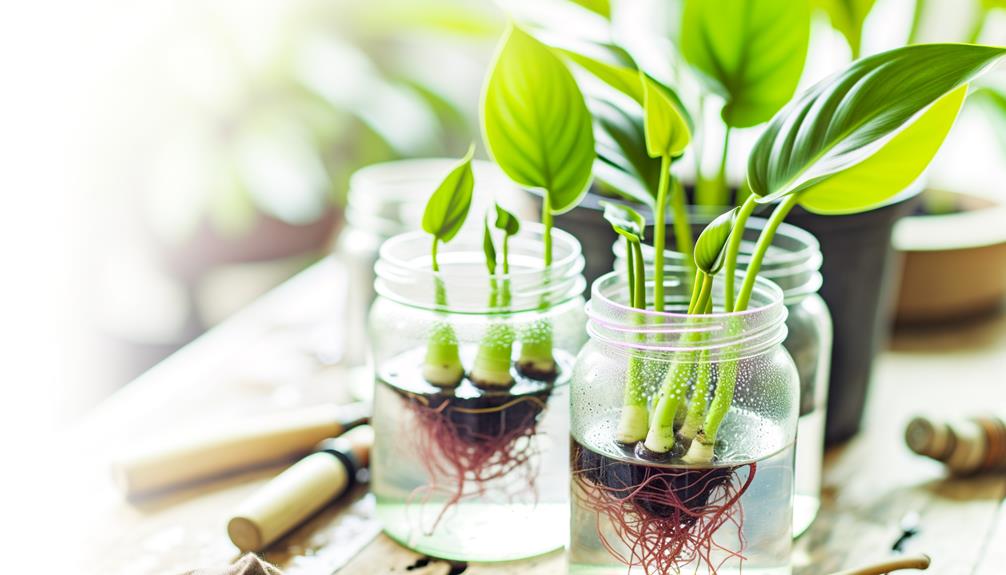How to Propagate Philodendron Black Cardinal? Easy Steps!
To propagate a Philodendron Black Cardinal, start by choosing a healthy stem with vibrant leaves. Utilize sterilized pruning shears to make a clean cut just below a node.
Immerse the cut end in rooting hormone powder to improve root development. Position the cutting in water, ensuring it receives indirect sunlight and changed water regularly.
Once roots develop, transfer the cutting to a well-draining potting mix consisting of perlite, peat moss, and compost. Maintain high humidity and steady temperatures during the rooting phase.
After successfully rooting, transplant into a larger pot with sufficient drainage to promote growth. Explore the detailed steps and care techniques for optimal propagation.

Key Takeaways
- Use sterile pruning shears to cut a healthy 4-6 inch stem below a node.
- Dip the cut end in rooting hormone powder to encourage root development.
- Place the cutting in a container with sterile, well-draining potting mix.
- Maintain high humidity and indirect bright light during the rooting process.
- Ensure the soil is lightly watered and free from fungal infections.
Gather Your Supplies
To successfully propagate a Philodendron Black Cardinal, begin by assembling all necessary supplies. Essential items include a pair of sterile pruning shears, a clean, sharp knife, rooting hormone powder, and a container filled with sterile, well-draining potting mix.
It’s also advisable to have a glass of water or a propagation station if water propagation is preferred. Make sure you have rubbing alcohol or a disinfectant to sterilize tools, reducing the risk of disease transmission.
Additionally, prepare a plastic bag or humidity dome to maintain high humidity levels during initial root development. Proper preparation and having all required materials at hand will streamline the propagation process, enhancing the likelihood of successful plant growth and health.
Select a Healthy Stem
After gathering your supplies, the next step involves selecting a healthy stem from the Philodendron Black Cardinal to guarantee successful propagation.
Choose a stem that exhibits robust growth, characterized by vibrant, unmarred leaves and a firm, non-wrinkled texture. The ideal stem should be at least 4-6 inches in length and possess several nodes, which are vital for root development.
Avoid any stems showing signs of disease, such as discoloration, spots, or wilting. Make sure the stem is free from pests like aphids or mites, which can impede propagation.
Selecting a pristine, vigorous stem is essential, as it significantly enhances the likelihood of producing a healthy and thriving new plant.
Make the Cut
When making the cut for propagating Philodendron Black Cardinal, it is important to choose the best cutting location, typically just below a node.
Use sterilized, sharp cutting tools to prevent infection and guarantee a clean, precise cut.
This minimizes harm to the plant and promotes healthy regrowth.
Choose Cutting Location
Selecting the best cutting location is crucial for successful propagation of the Philodendron Black Cardinal. Begin by identifying a healthy, mature stem with several nodes, as nodes are crucial for root development. Confirm the chosen stem is disease-free and exhibits robust growth.
Key considerations include:
- Node Presence: Select a stem with at least one or two nodes, as these are the sites where roots will emerge.
- Stem Health: Opt for a stem that is neither too young nor too old, making sure it is firm and vigorous.
- Leaf Configuration: Choose a cutting with at least one or two leaves to facilitate photosynthesis during the rooting phase.
Proper Cutting Tools
Using the appropriate cutting tools is essential to secure a clean cut and promote healthy propagation of the Philodendron Black Cardinal. The primary tools required are a pair of sharp, sterilized pruning shears or a sterilized knife.
Making sure the blade is sharp minimizes tissue damage, which can otherwise lead to infections or hinder the plant’s ability to develop roots. Sterilization, achieved using rubbing alcohol or a bleach solution, is vital to eliminate pathogens that could cause disease.
Additionally, having a clean, stable work surface and appropriate protective gear, such as gloves, enhances precision and safety during the cutting process. The correct use of these tools secures the plant cuttings are primed for successful propagation.
Ensure Clean Cut
With the appropriate cutting tools prepared, proceed to make a single, clean slice just below a node on the Philodendron Black Cardinal stem. Guaranteeing a precise slice is essential for the health and success of the propagation process.
Utilize sterilized, sharp tools to minimize tissue damage and reduce the risk of infection. The slice should be smooth and swift, avoiding jagged edges that could hinder root development.
Key considerations for making the slice include:
- Node Identification: Ensure the slice is made just below a healthy node, as this is where new roots will emerge.
- Tool Sterilization: Sterilize cutting tools with alcohol or bleach solution to prevent pathogen transmission.
- Angle of Slice: Make the slice at a slight angle to maximize surface area for root growth.
Rooting in Water
When rooting Philodendron Black Cardinal cuttings in water, it is important to start with healthy, disease-free cuttings to achieve best growth. Regularly check the cuttings for root development, maintaining water cleanliness to prevent bacterial growth.
Observing these practices will promote strong, viable roots ready for potting.
Selecting Healthy Cuttings
To guarantee successful propagation of Philodendron Black Cardinal, it is important to select cuttings that are healthy, disease-free, and possess at least one node and a few leaves. This ensures that the cutting has the necessary resources to develop roots and sustain itself during the propagation process.
When choosing a cutting, consider the following criteria:
- Vigorous Growth: Select cuttings from the healthiest, most robust parts of the plant.
- Disease-Free: Verify there are no signs of pests, rot, or fungal infections.
- Node Presence: Confirm that each cutting includes at least one node, which is essential for root development.
Monitoring Root Development
After selecting healthy cuttings, place them in a clean container filled with water to initiate root development. Make sure the water is at room temperature and that only the nodes are submerged while keeping the leaves above the waterline.
Position the container in a location with indirect sunlight to avoid leaf scorch. Monitor the water level regularly, topping up as necessary, and change the water every 3-5 days to prevent bacterial growth.
Observe the cuttings closely for signs of root emergence, typically within 2-4 weeks. Once roots are approximately one inch long, the cuttings are ready for transplantation into soil.
Consistent monitoring ensures ideal conditions, promoting robust root systems essential for successful plant propagation.
Plant in Soil
Choosing a well-draining potting mix is essential for planting Philodendron Black Cardinal in soil to guarantee ideal root health and growth. A suitable potting mix can significantly impact the plant’s ability to thrive by ensuring adequate aeration and moisture retention.
Key components of an effective potting mix include:
- Perlite: Enhances drainage and aeration, preventing root rot.
- Peat moss: Provides moisture retention while maintaining a light texture.
- Compost: Supplies essential nutrients and aids in healthy root development.
Combine these ingredients to create a balanced mix that supports robust root systems.
The chosen container should have drainage holes to facilitate excess water escape, further safeguarding against waterlogged conditions.
Proper soil composition is pivotal in fostering a strong foundation for the Philodendron Black Cardinal’s continued growth.
Care During Rooting
Maintaining best care during the rooting phase is vital for the successful establishment of Philodendron Black Cardinal cuttings. Maintain a steady temperature between 70-75°F (21-24°C) to facilitate root development.
High humidity, around 70-80%, is necessary; using a humidity dome or misting regularly can achieve this. Ensure indirect but bright light exposure, avoiding direct sunlight, which can harm tender cuttings.
Water the soil lightly, keeping it moist but not waterlogged to prevent rot. Monitor for signs of fungal infection, using sterilized tools and containers to reduce risk. Rooting hormone can improve success rates, but it is optional.
Within 3-4 weeks, roots should develop, indicating the cuttings are ready for the next phase of growth.
Transplanting the New Plant
Once the roots have sufficiently developed, it is time to transplant the Philodendron Black Cardinal cuttings into a well-draining potting mix to promote further growth.
Select a pot with adequate drainage and fill it with a mix that retains some moisture while allowing excess water to escape. Carefully place the rooted cuttings into the pot, making sure the roots are adequately covered and the plant is stable.
Key considerations include:
- Pot Size: Opt for a pot that allows room for root expansion without being excessively large.
- Watering: Water the newly transplanted cuttings thoroughly, then allow the soil to dry slightly between waterings.
- Light: Position the plant in indirect sunlight to encourage robust, healthy growth.
These steps will guarantee successful transplantation and continued development.
Conclusion
Propagating Philodendron ‘Black Cardinal’ involves a series of precise steps. It starts with selecting a healthy stem and making an appropriate cut. The next step is rooting in water, followed by eventual transplantation into soil.
Importantly, studies indicate that cuttings have a 90% success rate when proper techniques are followed. This high success rate underscores the effectiveness of these propagation methods. It ensures that even novice horticulturists can successfully propagate this particular species with relative ease.






